Overview
Selecting the appropriate protein powder containers is essential for preserving product quality and ensuring compliance with industry regulations. These containers safeguard contents from environmental factors, prevent contamination, and provide essential labeling information. Proper selection not only adheres to safety standards but also bolsters brand image and fosters consumer trust.
It is vital to consider:
- Material choice
- Design features
- Regulatory adherence
throughout the packaging process. By prioritizing these elements, businesses can enhance their market position and assure customers of their commitment to quality.
Introduction
Selecting the appropriate protein powder container is a pivotal decision that can profoundly influence product quality, consumer trust, and regulatory compliance. These containers serve a purpose beyond merely holding the product; they safeguard against environmental factors, prevent contamination, and convey vital information to users. Given the myriad of options available, how can manufacturers ensure they are making the optimal choice for their brand and customers? This article explores essential considerations for selecting protein powder containers that not only comply with industry standards but also elevate user experience and bolster brand reputation.
Understand the Importance of Container Selection for Protein Powders
Choosing the appropriate protein powder containers is essential for maintaining quality and ensuring compliance with industry regulations. Containers fulfill multiple critical functions:
- They shield the contents from environmental factors.
- They prevent contamination.
- They convey vital information to users.
A thoughtfully selected vessel not only safeguards the product but also enhances brand image and fosters consumer trust, making it a pivotal aspect of marketing. Furthermore, understanding the implications of packaging choices can help avert costly compliance issues, ensuring that your product meets all necessary safety and labeling standards.
For instance, employing high-quality, airtight storage solutions significantly reduces the risk of moisture exposure, which is crucial for preserving the integrity of protein powders. This meticulous attention to detail not only satisfies regulatory requirements but also in the product’s quality.
As Peter Drucker aptly noted, 'There is nothing so pointless as performing efficiently that which should not be done at all,' underscoring that the right selection is not solely about efficiency but also about ensuring quality and compliance. Additionally, as Benjamin Franklin warned, 'The bitterness of poor quality remains long after the sweetness of low price is forgotten,' highlighting the enduring consequences of neglecting proper selection.
Continuous improvement in packaging choices is vital, as it is not merely a one-time decision but part of an ongoing commitment to uphold quality.
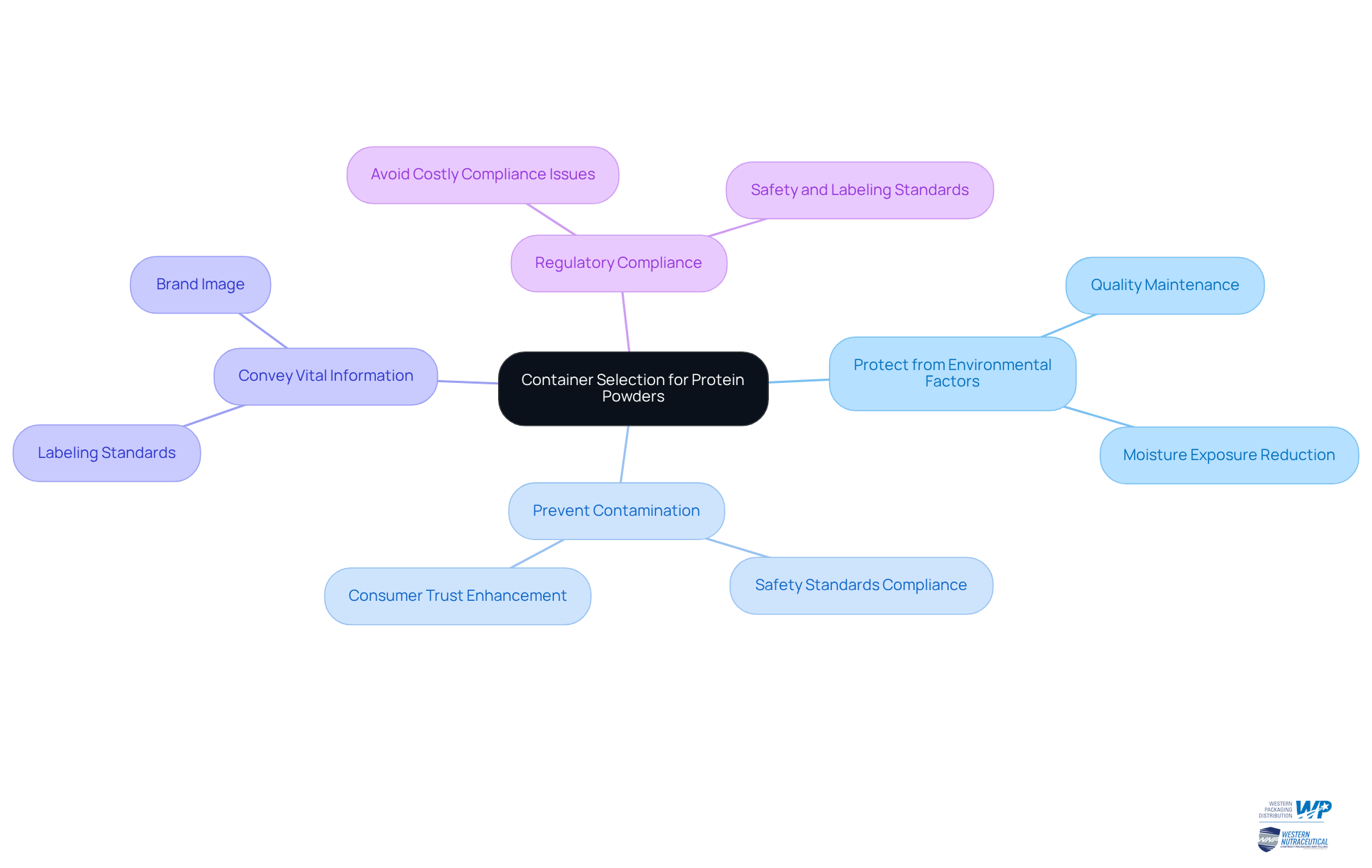
Identify Key Factors in Choosing Protein Powder Containers
When selecting protein powder containers, several key factors must be considered to ensure their optimal freshness and compliance.
- Material: It is essential to choose materials that are safe for food contact and provide effective protection against moisture, light, and air. Common options include high-density polyethylene (HDPE) and glass, both of which offer excellent barrier properties. At Western Packaging, we provide flexible packaging solutions that guarantee your items are well-protected against tampering and environmental influences.
- Size: The container should be appropriately sized to hold the volume of goods while remaining convenient for users. Consider typical serving sizes to minimize waste and enhance usability, which can also reduce spoilage and maintain compliance. Our innovative designs enhance your item's shelf appeal, making it more attractive to consumers.
- Closure Type: A secure closure mechanism is crucial to prevent spillage and contamination. Options such as screw tops, snap lids, and vacuum seals effectively maintain item integrity. Ensuring that closures are tamper-evident can further protect against potential issues. Western Packaging offers integrated filling services that enhance both product appeal and security.
- Labeling Space: Ensure that the container provides sufficient space for clear and compliant labeling, including nutritional information and usage instructions. This is essential for meeting regulatory standards and boosting public trust. Integrating QR codes can connect to online resources, offering transparency and involving users. Our graphic design expertise ensures that your labels and brochures create a cohesive and captivating brand identity.
- User Experience: Ease of use is paramount, especially for individuals on the go. Features like wide openings and ergonomic designs can significantly improve user satisfaction and encourage repeat purchases. By partnering with Western Packaging, you can leverage our experience in crafting compelling packaging solutions that resonate with your target audience.
By thoughtfully assessing these elements and employing the provided by Western Packaging, manufacturers can choose the most appropriate vessels for powders, ensuring quality and consumer attraction.
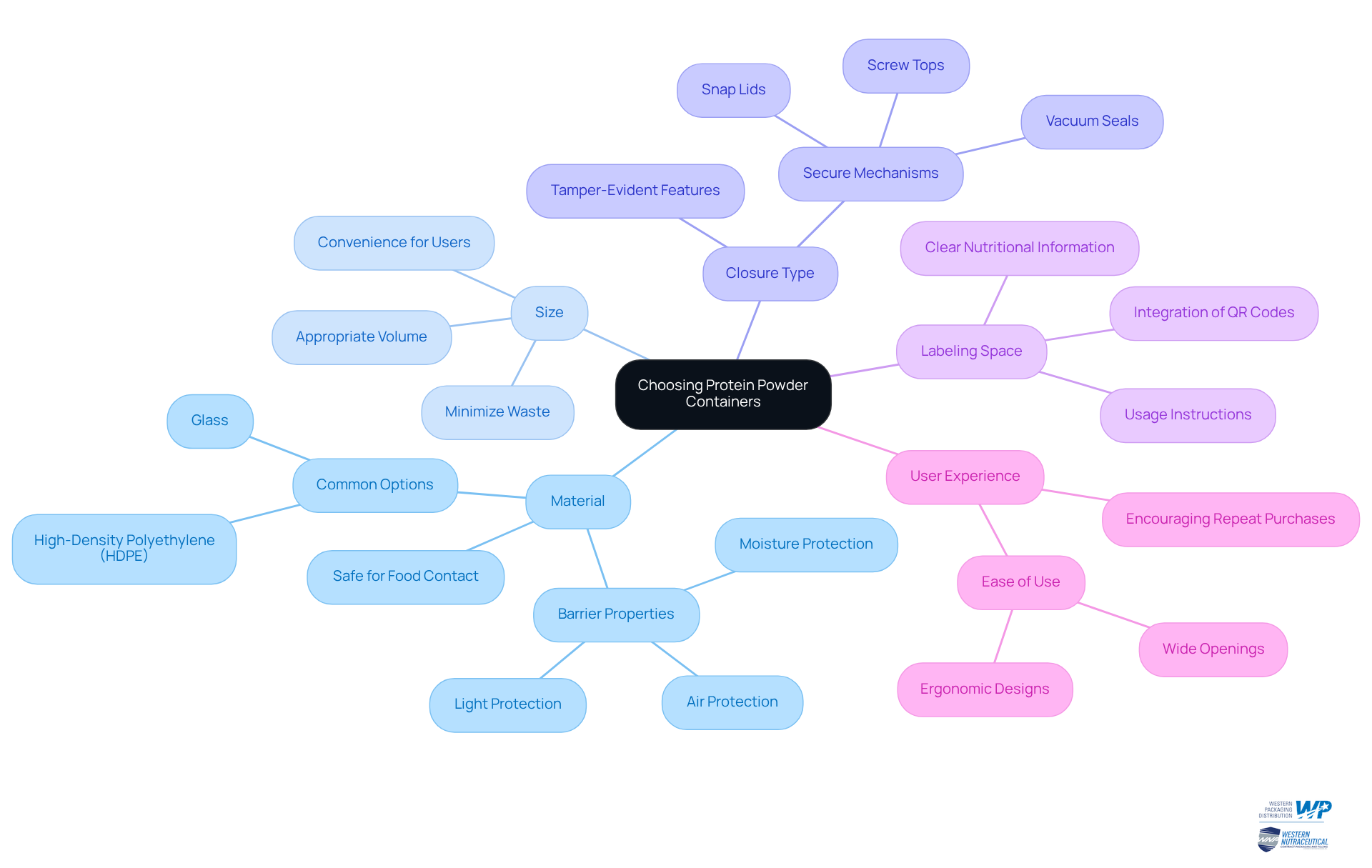
Evaluate Container Options Based on Material and Design
To effectively evaluate container options for protein powders, it is essential to consider several key aspects:
- Material Properties: Different materials offer unique benefits. Protein powder containers made of glass are non-reactive and provide outstanding moisture protection, making them ideal for maintaining product integrity. Conversely, certain protein powder containers are lightweight and cost-effective, catering to budget-conscious brands while still ensuring adequate protection. Western Packaging specializes in discovering optimal tailored to your needs, including large pouches for protein items, protein powder containers, and stick packs for nutraceuticals, ensuring that your selection of materials enhances appeal.
- Design Features: Innovative design elements can significantly enhance functionality. Features such as easy-pour spouts and built-in measuring scoops not only improve user experience but also encourage repeat purchases by making the product more convenient to use. With Western Packaging's expertise in packaging design, you can craft compelling graphic assets that elevate your brand recognition and shelf appeal. Addressing slack fill, a common issue in the industry, can further enhance public perception of value.
- Aesthetic Appeal: The visual design of the container should resonate with your brand identity. A careful evaluation of colors, shapes, and finishes can appeal to your intended audience and communicate a sense of quality and dependability, which is essential for establishing trust. With Western Packaging's innovative solutions, you can ensure that your packaging stands out on the shelf, effectively communicating your brand's values.
- Sustainability: As the demand for eco-friendly items increases, incorporating recyclable or biodegradable materials into your packaging can meet these expectations. This commitment to sustainability not only enhances brand loyalty but also positions your product favorably in a competitive market. For instance, initiatives like PlantFusion's use of fully compostable pouches exemplify a successful approach to sustainable packaging, aligning with Western Packaging's offerings.
By concentrating on these factors, manufacturers can select protein powder containers that not only align with industry standards but also connect with consumers, ultimately enhancing brand success. Moreover, with the packaging market for nutrients expected to expand considerably, understanding these factors is crucial for maintaining a competitive edge.
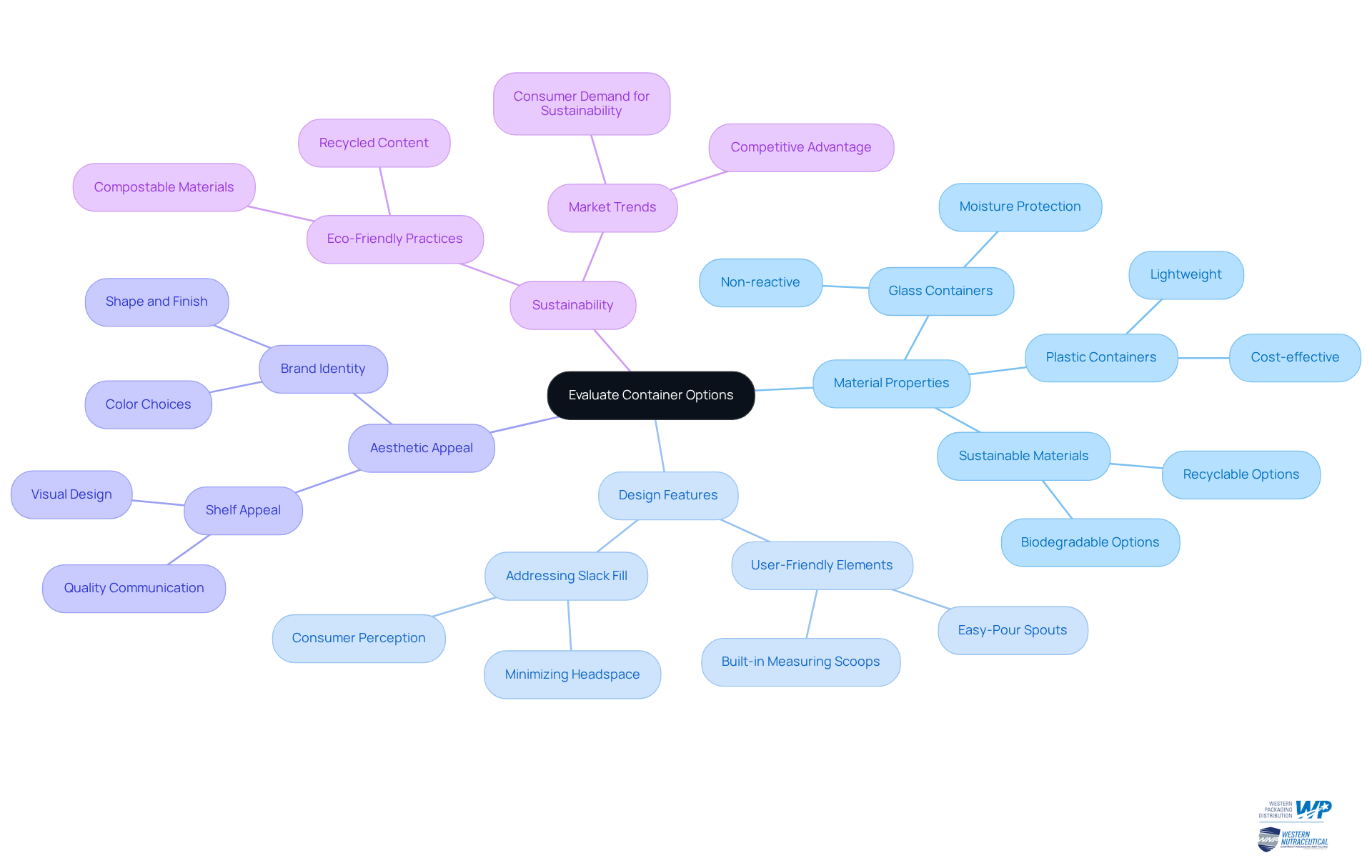
Ensure Regulatory Compliance in Container Selection
To ensure regulatory compliance when selecting protein powder containers, it is essential to adhere to the following guidelines:
- Familiarize Yourself with Regulations: Gain a thorough understanding of the regulations governing dietary supplements and food packaging in your area. This includes labeling requirements, material safety standards, and specific guidelines applicable to protein powder containers.
- Consult Regulatory Bodies: Engage with organizations such as the FDA or local health authorities to clarify compliance requirements. These entities offer valuable resources and guidance that can help navigate complex regulations.
- Conduct Material Safety Assessments: Verify that the materials used in your protein powder containers are approved for food contact and do not leach harmful substances into the items. This step is essential for ensuring buyer safety and item integrity.
- Ensure Label Compliance: Ensure that all labels on protein powder containers comply with regulatory standards, including ingredient lists, nutritional information, and any health claims. Non-compliance can lead to substantial penalties and harm to public trust. Additionally, manufacturers must submit a notification to the FDA within 30 days after marketing a dietary supplement with a claim.
Statistics reveal that 63% of customers state that packaging is as significant as the brand itself, while 70% acknowledge they purchase an item solely due to its packaging. By adhering to these guidelines, manufacturers can effectively traverse the regulatory environment, ensuring that their supplement offerings are both compliant and attractive to consumers. As Ashish R. Talati, an expert on FDA regulatory matters, notes, "The sooner nutraceutical companies adapt, the better positioned they’ll be to manage costs, meet regulations, and stand out in a crowded market.
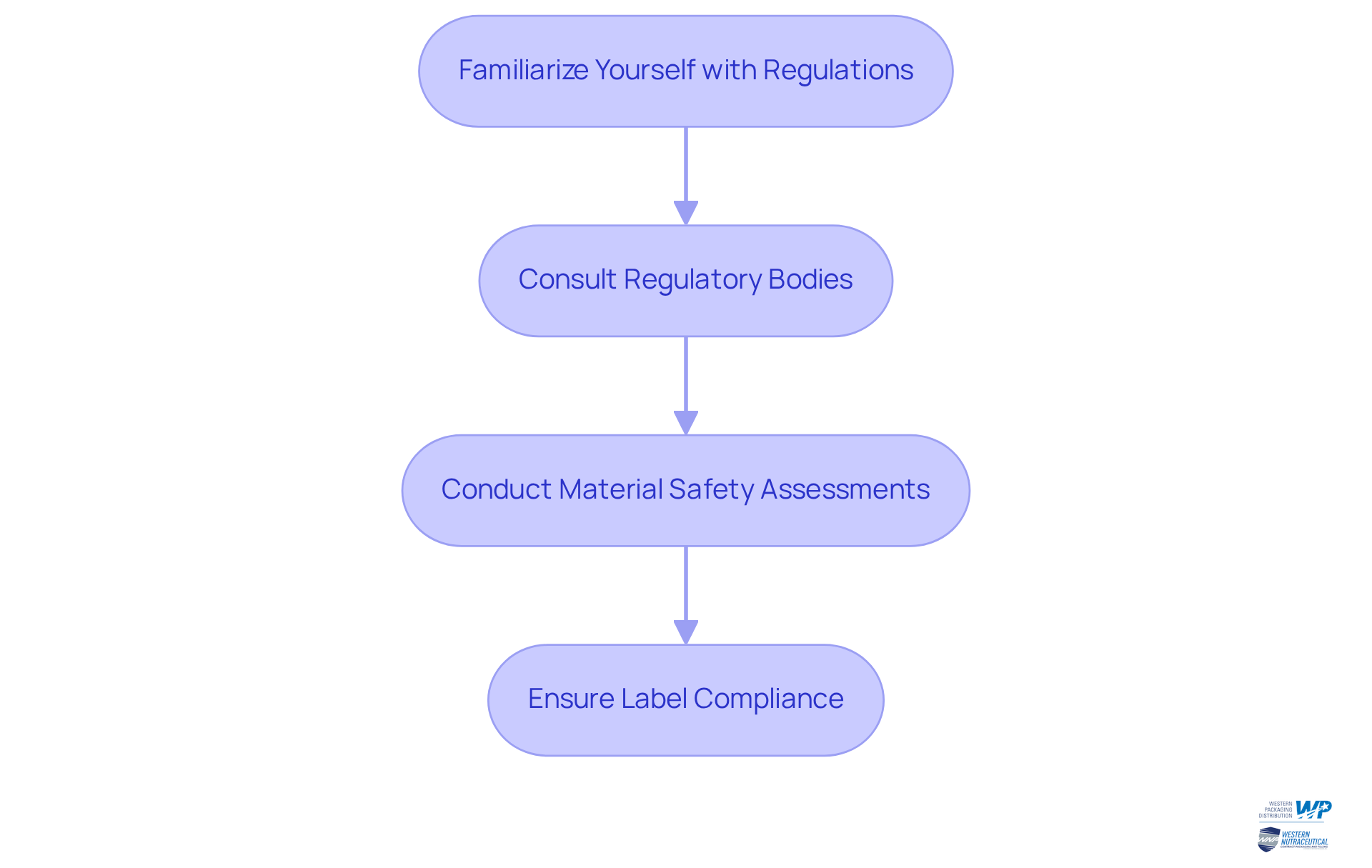
Source Reliable Suppliers for Protein Powder Containers
When sourcing suppliers for protein powder containers, it is crucial to follow these essential steps to ensure compliance and quality:
- Research Potential Suppliers: Begin by identifying suppliers with a solid reputation in the nutraceutical industry. It is imperative to verify their certifications and adherence to safety standards, as these factors are critical for maintaining product integrity. The global dietary supplement market is projected to reach $32.6 billion by 2027, underscoring the importance of selecting trustworthy suppliers in this expanding industry.
- Request Samples: Prior to placing a bulk order, acquire samples to evaluate the quality of the packaging. Assess their durability, usability, and aesthetic appeal to ensure they align with your brand's standards.
- Evaluate Supplier Reliability: Assess key factors such as lead times, customer service responsiveness, and the supplier's capacity to adapt to your specific requirements. A dependable supplier should effectively manage fluctuations in order volume and guarantee timely deliveries. Average lead times for protein powder containers suppliers can vary, making it essential to clarify this during your evaluation.
- Check References and Reviews: Collect feedback from other businesses that have partnered with the supplier. Positive testimonials and reviews offer valuable insights into their reliability and product quality, aiding you in making an informed decision. As Emily Chen, a digital marketing strategist, emphasizes, building a community around your brand fosters customer engagement and loyalty, which can extend to supplier relationships.
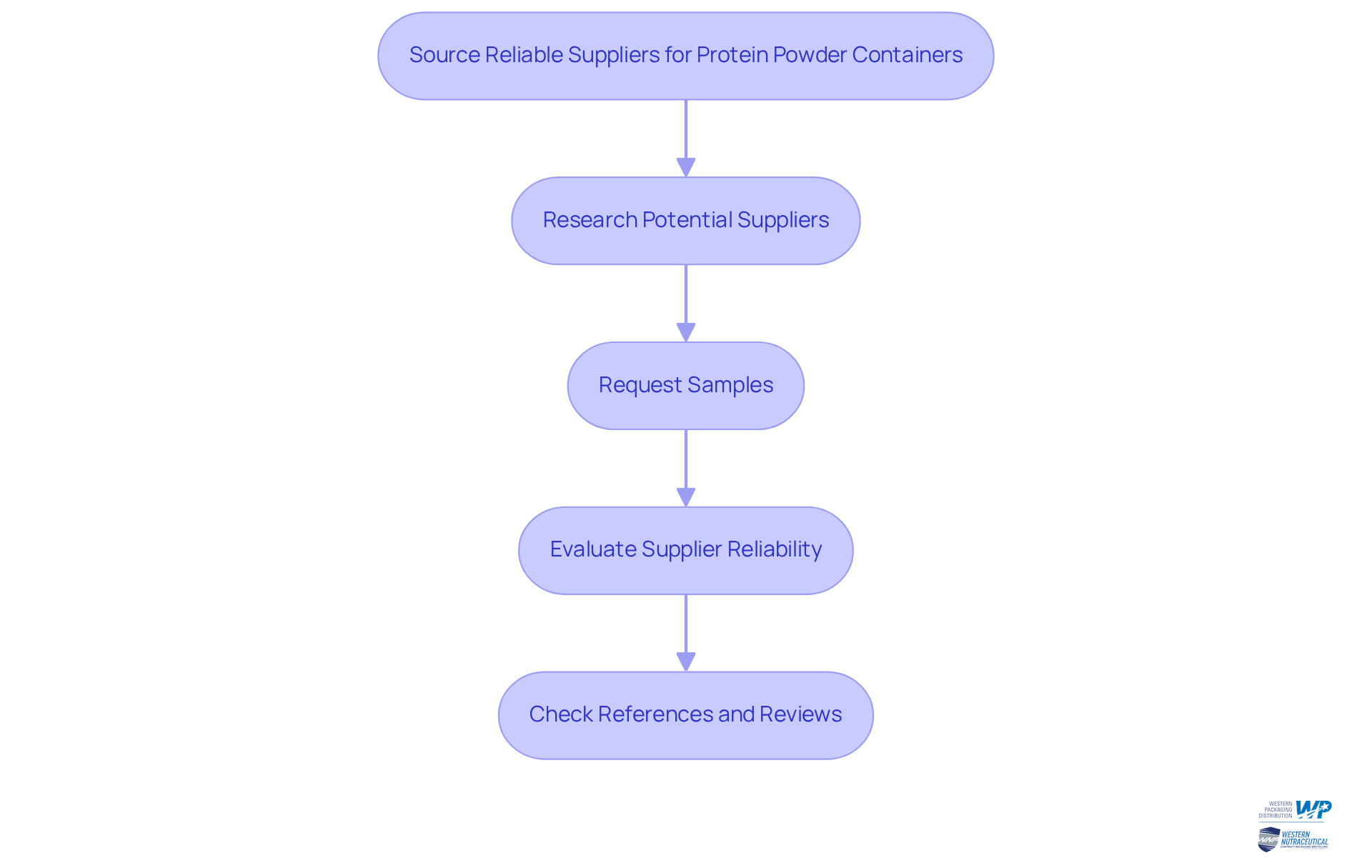
Conclusion
Choosing the right containers for protein powders transcends mere convenience; it is a pivotal decision that significantly impacts product quality, regulatory compliance, and consumer trust. The selection process demands careful consideration of various factors, including:
- Material safety
- Container size
- Closure mechanisms
- Labeling
- User experience
Each element is crucial in ensuring that protein powders remain fresh, safe, and appealing to consumers while adhering to regulatory standards.
Key insights discussed throughout the article underscore the importance of utilizing high-quality materials such as HDPE and glass, the necessity of secure closures to prevent contamination, and the value of effective labeling for compliance. Additionally, sourcing reliable suppliers and understanding regulatory requirements emerge as essential steps to guarantee that protein powder containers meet industry standards. By focusing on these critical aspects, manufacturers can devise packaging solutions that not only protect the product but also enhance brand perception and foster consumer loyalty.
Ultimately, the selection of protein powder containers reflects a brand's unwavering commitment to quality and compliance. As the nutritional products market continues to expand, investing in appropriate container choices will yield long-term benefits, ensuring that brands distinguish themselves in a competitive landscape. A thoughtful evaluation of options, prioritizing quality, will resonate with consumers, fostering trust and encouraging repeat purchases.
Frequently Asked Questions
Why is container selection important for protein powders?
Container selection is crucial for maintaining quality and ensuring compliance with industry regulations. Containers protect the contents from environmental factors, prevent contamination, and convey vital information to users.
What are the critical functions of protein powder containers?
Protein powder containers shield the contents from environmental factors, prevent contamination, and provide important information to users about the product.
How does proper container selection impact brand image and consumer trust?
A well-chosen container not only safeguards the product but also enhances brand image and fosters consumer trust, making it a pivotal aspect of marketing.
What are the consequences of neglecting proper container selection?
Neglecting proper selection can lead to costly compliance issues, poor product quality, and a negative impact on consumer confidence.
What materials are recommended for protein powder containers?
Recommended materials include high-density polyethylene (HDPE) and glass, as they are safe for food contact and offer effective protection against moisture, light, and air.
How should the size of a protein powder container be determined?
The container should be appropriately sized to hold the volume of goods while remaining convenient for users, considering typical serving sizes to minimize waste and enhance usability.
What types of closure mechanisms are effective for protein powder containers?
Effective closure mechanisms include screw tops, snap lids, and vacuum seals, which help prevent spillage and contamination. Tamper-evident closures can further enhance product security.
Why is labeling space important on protein powder containers?
Sufficient labeling space is essential for clear and compliant labeling, including nutritional information and usage instructions, which helps meet regulatory standards and boosts public trust.
How can user experience be improved with protein powder containers?
User experience can be improved through features like wide openings and ergonomic designs, which enhance satisfaction and encourage repeat purchases.
What role does continuous improvement play in packaging choices?
Continuous improvement in packaging choices is vital as it reflects an ongoing commitment to uphold quality, rather than being a one-time decision.




